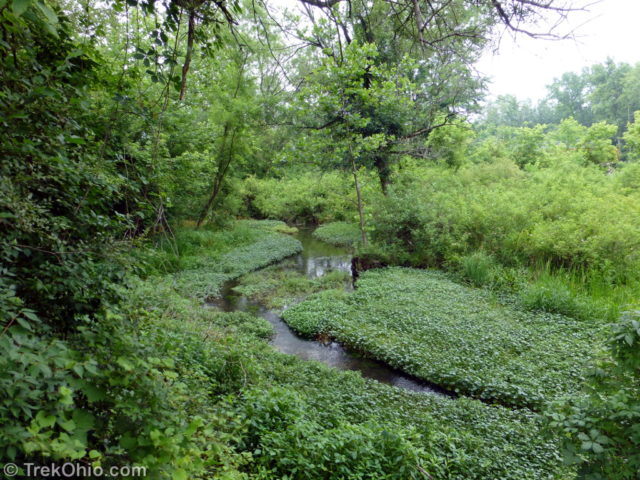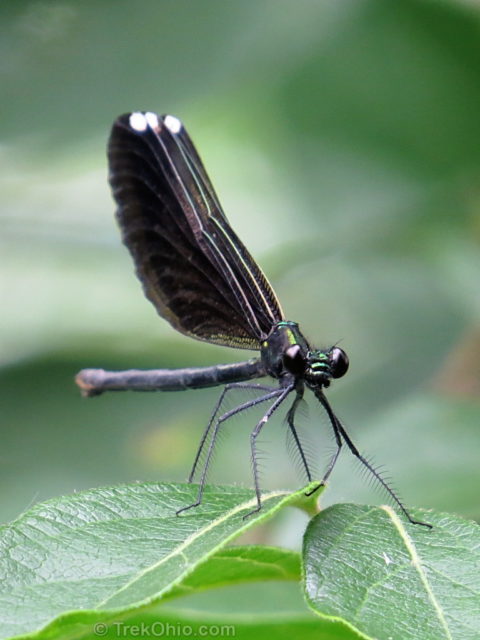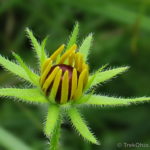Estel Wenrick Wetlands is a 255-acre preserve that’s part of the Clark County Park District in southwest Ohio. Bob and I visited the preserve in late June of last year. As the park district makes clear, recreational use takes a back seat to preserving this high-quality wetland. Although there is a trail and even a boardwalk for the benefit of hikers and birdwatchers, portions of the trail are overgrown, and we encountered a couple downed trees stretching across the trail. But as you can see from the photos below, the preserve is a pretty place, and Bob and I both enjoyed it. If like us, you go during the summer, I highly recommend applying DEET, and once you’ve done that, apply DEET again. And if you decide to explore the more overgrown portions of the trail, I’d recommend wearing long pants to protect against poison ivy.

From the parking lot off of Union Road, there is a clearly marked trailhead. If you explore the entire trail, you’ll discover that it is a loop trail. The main portion of the loop is a wide, straight trail that was a rail bed for an interurban railway during the early, twentieth century. This portion of the trail is relatively easy to hike.


Near this beginning of this part of the trail there was a ground cover of wild ginger.

To the south of the rail-bed portion of the trail, there is a narrow, overgrown trail that leads down into and through the wetland. The hiking here is more challenging, but interesting. If you would like to leave the rail bed portion of the trail to explore the wetland, you go down a narrow trail near the bench pictured below.

To give you an idea of how overgrown some portions of the trail were, here are a couple photos of the boardwalk.

And here’s an even more overgrown part of the boardwalk.

And to think I forgot to bring my machete. ![]() As I noted previously, there were also a couple trees across the trail.
As I noted previously, there were also a couple trees across the trail.



The green stream above is the same one featured in the topmost photo of this post. The green is from floating duckweed. Below you can see a bullfrog happily immersed in it.





Below are a few photos of areas with pooling, or slowly moving water. You can reach most of these wet areas from the rail bed portion of the trail without having to go through the weeds.




We saw quite a few damselflies during our hike. The ones pictured below are Ebony Jewelwing.


We also passed both flowers and fruit along the trail.






We followed the trail until we emerged in a small, municipal park in Medway, Ohio. Bob had packed a lunch for us in his daypack, and it was wonderful getting to sit at a picnic table while we ate it. The park had a couple interesting signs about historic people and places related to this part of Ohio. After eating we hiked back to the parking lot off Union Road, this time taking the easier portion of the trail located on the former rail bed.

The Mad River passes through the Estel Wenrick Wetlands, but it is quite a ways south of the trail, so it wasn’t visible to us while we were hiking. Had we been here during the spring, we may have been able to observe Great Blue Herons tending their young at the preserve’s heron rookery. According to prerserve’s official site, there are about 60 Great Blue Heron nests located in just two trees; the rookery is visible from Spangler Road. Although we didn’t see this particular rookery, we have visited others and they are definitely worth checking out.
Among the 255 plant species growing in the preserve is one of North America’s rarest orchids, the eastern prairie fringed orchid (Platanthera leucophaea). Although we didn’t see it ourselves, I’ve linked to an illustrated article about it in Related reading below.
Surprisingly I didn’t uncover any information at the preserve, or at the park district’s website, explaining who Estel Wenrick is. I can only assume she either gave the land to the park district or was instrumental in some way in the wetland becoming a preserve.
Additional information
- TrekOhio: Clark County Parks & Nature Preserves – includes a link to the official site of the Estel Wetlands Preserve, plus information on other nearby parks and preserves.
- TrekOhio: Heron Rookeries (Heronries) in Ohio – TrekOhio – although we didn’t see the heron rookery at Estel Wetlands, this post includes some photos of another heron rookery, plus information about other heron rookeries located throughout the state.
- Field Biology in Southeastern Ohio: Some Ohio Roses – how to identify Ohio’s four types of wild roses: Carolina Rose, Prairie Rose, Swamp Rose, and Multiflora Rose.
- Buckeye Botanist: The Federally Threatened Prairie Fringed Orchid – photos and background information on this very rare orchid.
Location
- Address: 2855 Union Rd., Medway, Ohio 45341
- GPS coordinates: 39.883141, -83.993622
- Google Maps: View on map or get directions
In the map below the red marker to the far right (east) is the park entrance. The blue marker to the far left is the small, municipal park where we had lunch.
More on Clark County


That’s quite a swamp – the vegetation looks as thick as the subtropics! It must provide sanctuary to many wet woodland specialist species.
The vegetation was really lush; actually it was nice looking at the very green photos today since we’re currently blanketed in snow again. I’m happy to report that both of us managed to get through the preserve without getting poison ivy or ticks, so we had that going for us. 🙂 And you are quite right about the thriving plant and animal species there. I would have really liked to have seen the rare orchid, but I apparently didn’t know where to look to find it.